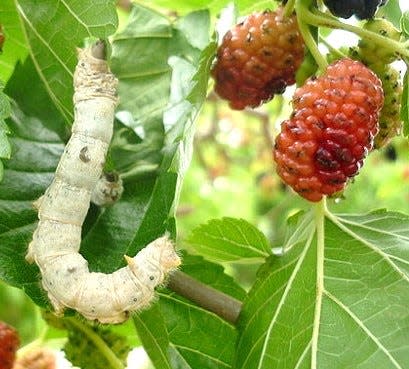Delaware's quick silk boom and bust: A fascination that failed to catch hold
- Oops!Something went wrong.Please try again later.
Bitcoins, non-fungible tokens (NFTs) and other viral schemes of recent years have sent prices skyrocketing only to plummet back to earth. Like the crypto crazes, runaway fads were nothing new in Delaware.
When the first Dutch settlers arrived at Cape Henlopen, Holland was in the middle of a tulip mania that inflated bulb prices until a single bulb could be worth as much as an average person could earn in a year. In the first half of the 19th century, a similar boom was ignited when southern Delaware became obsessed with mulberry trees and silkworms.
The boom started with the force of a wet firecracker after the Wilmington Delaware Register reported on April 11, 1829, “Books will be opened for the reception of subscriptions to the capital Stock of the Delaware Silk Company, in Georgetown, Sussex County, on Tuesday the 14th [of April].”

Southern Delaware investors, however, were skeptical and few appeared. In August, the newspaper reported, “Books were opened and closed, and the affair has died away.”
The idea of an American silk industry was not new. Several months before the rise and fall of the Delaware Silk Company, the Wilmington Delaware Journal noted that early attempts to establish a silk industry in America began with the first permanent English settlement in America:
“They were first commenced in Virginia, where the attention of the settlers was strongly directed to this subject by the British government. Silkworm eggs, white mulberry trees and printed instructions were sent over; and King James the First, finding he could not force the silk culture at home, hoped for better success in Virginia, which he was very desirous [to] raise silk instead of tobacco, the latter being a weed ‘which brings many disorders and inconveniences.’”
There were also attempts to raise silk in Georgia, Connecticut and, with the endorsement of Benjamin Franklin, in Pennsylvania. All failed.
After the American Revolution, members of Congress and others promoted the planting of mulberry trees to grow silkworms which would lead to the American manufacture of silk fabric. Delaware entrepreneurs were eager to join the expected boom.
DELAWARE HISTORY: How the DNA from 17th-century graves unearthed near Rehoboth may rewrite Delaware history
The Delaware Advertiser and farmer's Journal reported on March 12, 1829,” The Society for the promotion of culture of Mulberry Trees and raising of Silk Worms,” published a pamphlet with “ample instructions as to their management” which may have been the impetus for the Delaware Silk Company in Georgetown.
Despite the failure of the Delaware Silk Company, the cultivation of silkworms was revived a few years later, and this time, the idea caught on.
In 1839, Seaford resident, William Morgan (no relation to the author), purchased mulberry cuttings at $.40 each, and he soon had over 500 trees growing near his home in Seaford. Eventually, Morgan planted 1,000 more trees, but early spring weather had caused some of his trees to sprout, and some of these were killed by a late frost.

Nonetheless, about 4,000 silkworms hatched out, and in a few weeks, they produced ten pounds of raw silk. This, however, was nowhere nearly enough to cover the cost of Morgan’s trees.
As the silk market began to collapse, Morgan hoped to recover his costs by selling cuttings from his trees. He noted, however, “But alas! The humbug burst before the end of this year … Ah me, there is no sale for the cuttings or trees. The most complete death, sudden death, to this speculation that ever was to any kind of speculations in these United States.”
Anyone want to buy a non-fungible token?
SAGA OF THE BLACK-EYED SUSAN Snow Hill's Black-Eyed Susan gets a buyer, so what comes next in the boat's troubled saga?
Principal sources
Delaware Register, April 11, 1829; Aug. 15, 1829.
Delaware Advertiser and Farmer's Journal, March 12, 1829.
Delaware Journal, Feb. 24, 1829.
Federal Writers’ Project, Delaware, A Guide to the First State, New York: The Viking Press, 1938, pp. 83-84.
Harold B. Hancock, ed., “William Morgan’s Autobiography and Diary: Life in Sussex County, 1780-1857—Part II,” Delaware History, Fall-Winter, 1980, Vol. 19, No. 2, pp. 106-107.
This article originally appeared on Salisbury Daily Times: Quick silk boom and bust in Delaware: Fleeting fascination in history
